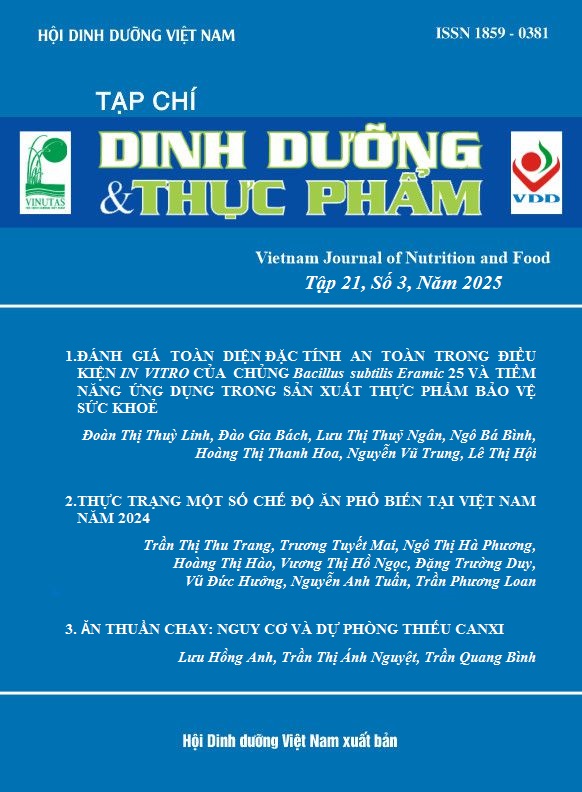ASSESSMENT OF THE CURRENT STATUS OF EQUIPMENT AND NEEDS IN 63 PROVINCES/CITIES OF VIETNAM
Main Article Content
Abstract
Aims: This study aims to assess the current status and needs regarding nutrition-related equipment across all 63 provinces and municipalities in Vietnam, thereby providing a scientific basis for the development of evidence-informed policies for equitable resource allocation.
Methods: A cross-sectional descriptive study was conducted using a self-administered questionnaire developed based on predefined criteria. The questionnaire was piloted and refined to ensure clarity and accuracy before being uploaded to Google Sheets. The survey link was distributed via Zalo and email to 63 nutrition officers at the provincial Centers for Disease Control and Prevention (CDCs). Respondents received detailed instructions and were expected to complete the form within a maximum of 30 days.
Results: The utilization rates of nutrition-related equipment improved from 2023 to 2025. Specifically, the usage rate of trough-type weighing scales increased from 78.50% to 85.83%; body weight scales rose from 72.50% to 85.54%; and length/height measuring devices increased from 70.84% to 83.37%. However, the extent to which these devices met local needs remained limited, ranging from only 47.72% to 63.52%. Notably, the demand for mid-upper arm circumference (MUAC) tapes was particularly high, with a shortfall of 19,252 units.
Conclusion: The study conducted across 63 provinces and municipalities in Vietnam highlights progress in the availability of nutrition equipment between 2023 and 2025. Nonetheless, existing resources remain insufficient to meet actual needs. Strategic policies are necessary to ensure equitable distribution, regular equipment maintenance and expanded dissemination of nutrition information—particularly given the uneven distribution of communication materials across age groups.
Keywords
Current status, needs, equipment for nutrition activity, center for control of diseases
Article Details
References
2. Thông tư số 28/2020/TT-BYT ngày 31/12/2020 của Bộ Y tế quy định danh mục trang thiết bị tối thiểu của trạm y tế tuyến xã
3. Smith, J. & Brown, K. Advanced Nutritional Measurement Technologies in Developed Countries. Journal of Public Health Technology. 2022;15(3):112-130.
4.World Bank. Suy dinh dưỡng dai dẳng trong cộng đồng các dân tộc thiểu số tại Việt Nam: Vấn đề và lựa chọn chính sách, can thiệp. Báo cáo nghiên cứu. 2019;1(2):23-40.
5.Đinh Văn Đông, Nguyễn Quang Dũng. Thực trạng triển khai hoạt động dinh dưỡng tại các bệnh viện đa khoa huyện, tỉnh Thanh Hóa năm 2024. Tạp chí Y học Cộng đồng. 2024;10(5):15-25.
6. Thông tư số 41/2011/TT-BYT ngày 14/11/2011 của Bộ Y tế: Hướng dẫn cấp chứng chỉ hành nghề đối với người hành nghề và cấp giấy phép hoạt động đối với cơ sở khám bệnh, chữa bệnh
7. Nghị định 98/2021/NĐ-CP về quản lý trang thiết bị y tế
8. Thông tư 05 05/2022/TT-BYT ngày 1/8/2022 quy định chi tiết thi hành một số điều của nghị định 98/2021/NĐ-CP về quản lý trang thiết bị y tế
Similar Articles
- Minh Anh NGUYEN, Thi Ho Ngoc VUONG, Thi Thu Trang TRAN, Duc Huong VU, Truong Duy DANG, Thi Ha Phuong NGO, Phuong Loan TRAN, Thi Hang HOANG, Thanh Duong TRAN, Tuyet Mai TRUONG, ASSESSMENT OF DIETARY INTAKE AND FOOD FREQUENCY OF CHILDREN UNDER 5 YEARS OLD IN SIN HO DISTRICT, LAI CHAU PROVINCE IN 2023 , Vietnam Journal of Nutrition & Food: Vol. 20 No. 6 (2024): SCIENTIFIC CONFERENCE OF THE NATIONAL INSTITUTE OF NUTRITION, 2024
You may also start an advanced similarity search for this article.


